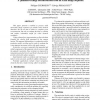461 search results - page 8 / 93 » Learning epipolar geometry from image sequences |
ACCV
2006
Springer
13 years 11 months ago
2006
Springer
The effect of reflection and transparency is superimposed in many real world scenes, which is caused by glass-like shiny and transparent materials. The presence of such incidental ...
ITCC
2003
IEEE
14 years 24 days ago
2003
IEEE
: Motion is an important cue for many applications. Here we propose a solution for estimating motion from a sequence of images using three algorithms, viz., Batch, Recursive and Bo...
SCIA
2011
Springer
12 years 10 months ago
2011
Springer
We present a non-incremental approach to structure from motion. Our solution is based on robustly computing global rotations from relative geometries and feeding these into the kno...
SI3D
2010
ACM
14 years 25 days ago
2010
ACM
Scattering in participating media, such as fog or haze, generates volumetric lighting effects known as crepuscular or god rays. Rendering such effects greatly enhances the realism...
AIPR
2001
IEEE
13 years 11 months ago
2001
IEEE
This paper presents a method to process axial monocular image sequences for mobile robot obstacle detection. We do not aim to achieve a complete scene reconstruction, but only to ...

